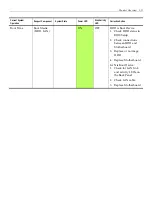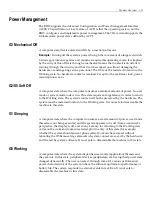
1-14 Product Overview
ACPI Sleep States (S0 - S5)
Under
the
G1
sleeping
state
ACPI
defines
levels
of
system
sleep
state
support.
The
7611
supports
the
following
sleeping
states:
•
S0:
Normal
Powered
‐
On
state
•
S1
(Standby):
The
S1
sleeping
state
is
a
low
wake
latency
sleeping
state.
In
this
state,
no
system
context
is
lost
(CPU
or
chip
set)
and
hardware
maintains
all
system
contexts.
Note:
The
7611
does
not
support
S1
state.
Turning
off
the
backlight
and
hard
drives
provides
the
equivalent
power
savings
(due
to
Intel
ʹ
s
processor
C
‐
states
feature)
at
nearly
zero
latency.
•
S2:
Not
supported
•
S3
(Suspend
to
Ram):
The
S3
sleeping
state
is
a
low
wake
latency
sleeping
state.
This
state
is
similar
to
the
S1
sleeping
state
except
that
the
CPU
and
system
cache
context
is
lost
(the
OS
is
responsible
for
maintaining
the
caches
and
CPU
context).
Control
starts
from
the
processor
ʹ
s
reset
vector
after
the
wake
event.
In
NCR
systems,
during
S3,
power
is
only
provided
to
the
on
‐
board
USB
ports.
Note:
When
the
terminal
resumes
from
an
S3
state,
all
the
USB
devices
re
‐
enumerate.
This
causes
speaker
tones
as
if
they
were
disconnected
and
then
reconnected.
This
does
not
present
a
problem
and
the
USB
devices
will
continue
to
operate
correctly.
Requirements
for
S3
support:
•
O/S
must
be
built
on
a
system
with
S3
enabled
in
the
BIOS
•
Some
peripherals
may
not
be
S3
capable,
which
can
prevent
the
system
from
entering
S3
state.
•
ʺ
S4
(Suspend
to
Disk):
The
S4
state
is
the
lowest
power,
longest
wake
latency
sleeping
state
supported
by
ACPI.
In
order
to
reduce
power
to
a
minimum,
it
is
assumed
that
the
hardware
platform
has
powered
off
all
devices.
Platform
context
is
maintained.
Requirements
for
S4
support:
•
O/S
must
be
built
on
a
system
with
S3
enabled
in
the
BIOS
•
Some
peripherals
may
not
be
S4
capable,
which
can
prevent
the
system
from
entering
S4
state.
Reference
the
ACPI
Specification
for
details.
Peripherals:
ACPI
defines
power
states
for
peripherals
which
are
separate
from
the
system
power
state.
The
device
power
states
range
from
D0
(fully
‐
on)
to
D3
(off)
It
is
the
responsibility
of
the
driver
developer
for
each
peripheral
to
define
and
support
the
available
power
states.
Summary of Contents for RealPOS 50
Page 1: ...NCR RealPOS 50 7611 Release 1 1 User Guide B005 0000 2017 Issue C...
Page 10: ...x...
Page 48: ...1 38 Product Overview...
Page 58: ...2 10 Hardware Installation USB Keyboard w Glide Pad 29246...
Page 88: ...2 40 Hardware Installation...
Page 122: ...6 6 BIOS Updating Procedure...
Page 136: ...7 14 Solid State Drive Optimization...
Page 143: ...2x20 Customer Display Interface 9 5 CP437...
Page 144: ...9 6 2x20 Customer Display Interface CP858...
Page 145: ...2x20 Customer Display Interface 9 7 CP866...
Page 146: ...9 8 2x20 Customer Display Interface CP932...
Page 147: ...2x20 Customer Display Interface 9 9...
Page 148: ...9 10 2x20 Customer Display Interface...
Page 154: ...10 6 Touch Screen Operation...
Page 156: ...A 2 Windows 7...















































